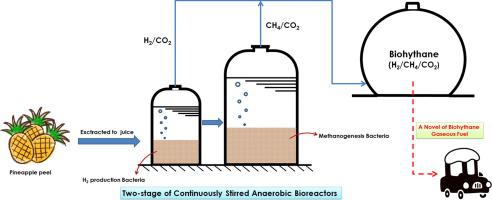Our official English website, www.x-mol.net, welcomes your
feedback! (Note: you will need to create a separate account there.)
A novel of biohythane gaseous fuel production from pineapple peel waste juice in two-stage of continuously stirred anaerobic bioreactors
Fuel ( IF 6.7 ) Pub Date : 2020-11-01 , DOI: 10.1016/j.fuel.2020.118526 Chen-Yeon Chu , Tan-Phat Vo , Tsung-Hsien Chen
Fuel ( IF 6.7 ) Pub Date : 2020-11-01 , DOI: 10.1016/j.fuel.2020.118526 Chen-Yeon Chu , Tan-Phat Vo , Tsung-Hsien Chen

|
Abstract This study integrated two continuous stirred anaerobic bioreactors (CSABR) for two-stage biohytane gaseous fuel (a mixture of hydrogen and methane) production at mesophilic condition. The first stage of biohydrogen production reactor (CSABRH) was fed by the pineapple peel waste juice with substrate concentration of 64.56 g COD/L. The hydrogenogenic effluent from CSABRH was directly fed to second stage of methane production reactor (CSABRC). The working volumes of CSABRH and CSABRC bioreactors were 1.2 and 5 L, respectively. Optimization of Hydraulic Retention Time (HRT) for two-stage hydrogen and methane production after an integration were examined. A maximum hydrogen production rate of 599.0 ± 77.8 mL/LR-d and methane production rate of 174.6 ± 9.4 mL/LR-d were achieved at optimal HRT of 4 h in the CSABRH and 3 d in the CSABRC with the substrate concentration of 66.15 ± 2 and 37.7 ± 1.9 g COD/L in the first and second stage, respectively. The two-stage reactors performed well in producing hydrogen and methane over 140 and 50 days with a total chemical oxygen demand (COD) removal efficiency of 85.0%. Total biogas and heating value production rates in total 6.2 L working volume were 2495.1 mL/d and 13.1 kcal/d, respectively. These results indicate that the pineapple peel waste could be efficiently used for biohythane (H2 + CH4) production and the two-stage process can operate successfully under high feeding flow rate conditions.
中文翻译:

两级连续搅拌厌氧生物反应器利用菠萝皮废液生产生物乙烷气体燃料的新方法
摘要 本研究将两个连续搅拌厌氧生物反应器 (CSABR) 集成在一起,用于在中温条件下进行两阶段 biohytane 气体燃料(氢气和甲烷的混合物)生产。第一阶段生物制氢反应器(CSABRH)由底物浓度为64.56 g COD/L的菠萝皮废汁供给。来自 CSABRH 的氢气流出物直接送入甲烷生产反应器 (CSABRC) 的第二阶段。CSABRH 和 CSABRC 生物反应器的工作容积分别为 1.2 和 5 L。检查了集成后两阶段氢气和甲烷生产的水力保留时间 (HRT) 的优化。最大产氢率为 599.0 ± 77.8 mL/LR-d,甲烷产率为 174.6 ± 9。在 CSABRH 中 4 h 和 CSABRC 中 3 d 的最佳 HRT 下达到 4 mL/LR-d,第一阶段和第二阶段的底物浓度分别为 66.15 ± 2 和 37.7 ± 1.9 g COD/L。两级反应器在 140 天和 50 天的生产氢气和甲烷方面表现良好,总化学需氧量 (COD) 去除效率为 85.0%。在总共 6.2 L 工作体积中,总沼气和热值生产率分别为 2495.1 mL/d 和 13.1 kcal/d。这些结果表明菠萝皮废料可以有效地用于生物乙烷 (H2 + CH4) 生产,并且两阶段工艺可以在高进料流速条件下成功运行。两级反应器在 140 天和 50 天的生产氢气和甲烷方面表现良好,总化学需氧量 (COD) 去除效率为 85.0%。在总共 6.2 L 工作体积中,总沼气和热值生产率分别为 2495.1 mL/d 和 13.1 kcal/d。这些结果表明,菠萝皮废料可以有效地用于生物乙烷 (H2 + CH4) 生产,并且两阶段工艺可以在高进料流速条件下成功运行。两级反应器在 140 天和 50 天的生产氢气和甲烷方面表现良好,总化学需氧量 (COD) 去除效率为 85.0%。在总共 6.2 L 工作体积中,总沼气和热值生产率分别为 2495.1 mL/d 和 13.1 kcal/d。这些结果表明菠萝皮废料可以有效地用于生物乙烷 (H2 + CH4) 生产,并且两阶段工艺可以在高进料流速条件下成功运行。
更新日期:2020-11-01
中文翻译:

两级连续搅拌厌氧生物反应器利用菠萝皮废液生产生物乙烷气体燃料的新方法
摘要 本研究将两个连续搅拌厌氧生物反应器 (CSABR) 集成在一起,用于在中温条件下进行两阶段 biohytane 气体燃料(氢气和甲烷的混合物)生产。第一阶段生物制氢反应器(CSABRH)由底物浓度为64.56 g COD/L的菠萝皮废汁供给。来自 CSABRH 的氢气流出物直接送入甲烷生产反应器 (CSABRC) 的第二阶段。CSABRH 和 CSABRC 生物反应器的工作容积分别为 1.2 和 5 L。检查了集成后两阶段氢气和甲烷生产的水力保留时间 (HRT) 的优化。最大产氢率为 599.0 ± 77.8 mL/LR-d,甲烷产率为 174.6 ± 9。在 CSABRH 中 4 h 和 CSABRC 中 3 d 的最佳 HRT 下达到 4 mL/LR-d,第一阶段和第二阶段的底物浓度分别为 66.15 ± 2 和 37.7 ± 1.9 g COD/L。两级反应器在 140 天和 50 天的生产氢气和甲烷方面表现良好,总化学需氧量 (COD) 去除效率为 85.0%。在总共 6.2 L 工作体积中,总沼气和热值生产率分别为 2495.1 mL/d 和 13.1 kcal/d。这些结果表明菠萝皮废料可以有效地用于生物乙烷 (H2 + CH4) 生产,并且两阶段工艺可以在高进料流速条件下成功运行。两级反应器在 140 天和 50 天的生产氢气和甲烷方面表现良好,总化学需氧量 (COD) 去除效率为 85.0%。在总共 6.2 L 工作体积中,总沼气和热值生产率分别为 2495.1 mL/d 和 13.1 kcal/d。这些结果表明,菠萝皮废料可以有效地用于生物乙烷 (H2 + CH4) 生产,并且两阶段工艺可以在高进料流速条件下成功运行。两级反应器在 140 天和 50 天的生产氢气和甲烷方面表现良好,总化学需氧量 (COD) 去除效率为 85.0%。在总共 6.2 L 工作体积中,总沼气和热值生产率分别为 2495.1 mL/d 和 13.1 kcal/d。这些结果表明菠萝皮废料可以有效地用于生物乙烷 (H2 + CH4) 生产,并且两阶段工艺可以在高进料流速条件下成功运行。











































 京公网安备 11010802027423号
京公网安备 11010802027423号